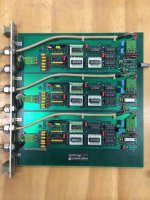asah
Plastic
- Joined
- Dec 2, 2013
- Location
- Cotati, CA
Starting a new thread here to share my build progress I have been sharing in the "fix your maho" thread.
I have a 1986 MH400E which was retrofitted with a 1991 phillips 432 control at some point. The control died a few months into owning it. I could have fixed it, but I was tired of handwriting GCode to use the thing. Very limiting for a control. The serial interface was buggy and slow... etc. So last week I pulled the plug on it. snipped the IO ribbon cables and plugged them into my Mesa IO boards and away I went.
Background on the machine and hardware I am using:
The mill is from the era of the fixed speed spindle and 18 speed gearbox, which is one of my bigger challenges ahead.
I am using the following mesa hardware:
5i23 - FPGA board
7i70 - 48 opto isolated outputs
7i70 - 48 opto isolated inputs
7i44 - 8 port smart serial card
7i52 - 6 port quadrature card
7i83 - 6 port analog servo interface card.
You could do all that I am doing with a much more minimal setup such as one of the 5i25/6i25 kits, but I have other plans for all this IO. =)
Yesterday I got to the point of full closed loop control (save some PID tuning) but several projects remain to finish the retrofit.
Spindle / Gearbox
Automatic lubrication
Tool Changer
remote pendant and control surface integration
Integrating computer into the old 432 location.
Touchscreen?
etc...
I'll post photos from the build and progress as I progress.
Overall things have been pretty straightforward, working through the schematics, learning them well, and progressing in small stages.
I have a 1986 MH400E which was retrofitted with a 1991 phillips 432 control at some point. The control died a few months into owning it. I could have fixed it, but I was tired of handwriting GCode to use the thing. Very limiting for a control. The serial interface was buggy and slow... etc. So last week I pulled the plug on it. snipped the IO ribbon cables and plugged them into my Mesa IO boards and away I went.
Background on the machine and hardware I am using:
The mill is from the era of the fixed speed spindle and 18 speed gearbox, which is one of my bigger challenges ahead.
I am using the following mesa hardware:
5i23 - FPGA board
7i70 - 48 opto isolated outputs
7i70 - 48 opto isolated inputs
7i44 - 8 port smart serial card
7i52 - 6 port quadrature card
7i83 - 6 port analog servo interface card.
You could do all that I am doing with a much more minimal setup such as one of the 5i25/6i25 kits, but I have other plans for all this IO. =)
Yesterday I got to the point of full closed loop control (save some PID tuning) but several projects remain to finish the retrofit.
Spindle / Gearbox
Automatic lubrication
Tool Changer
remote pendant and control surface integration
Integrating computer into the old 432 location.
Touchscreen?
etc...
I'll post photos from the build and progress as I progress.
Overall things have been pretty straightforward, working through the schematics, learning them well, and progressing in small stages.






 !
! Great work!
Great work!
